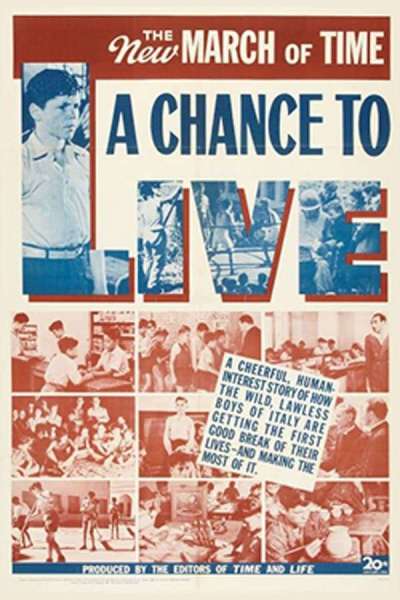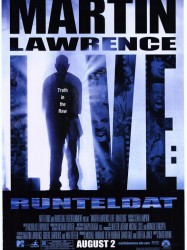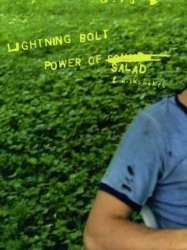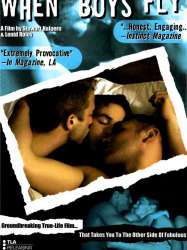A Chance to Live is a american film of genre Documentary directed by James L. Shute released in USA on 1 december 1949
A Chance to Live (1949)

If you like this film, let us know!
Released in USA 1 december 1949
Length 18minutes
Directed by James L. Shute
OriginUSA
Genres Documentary
Rating56%










A Chance to Live is a 1949 American short documentary film directed by James L. Shute, produced by Richard de Rochemont for Time Inc. and distributed by Twentieth Century-Fox. It is part of The March of Time series and portrays Monsignor John Patrick Carroll-Abbing building and running a Boys' Home in Italy.
The film won an Academy Award at the 22nd Academy Awards in 1950 for Documentary Short Subject.
Comments
Leave comment :
Suggestions of similar film to A Chance to Live
There are 0 films with the same director, 8965 with the same cinematographic genres, to have finally 70 suggestions of similar films.If you liked A Chance to Live, you will probably like those similar films :
 , 55minutes
, 55minutesGenres Documentary
Themes Environmental films, Seafaring films, Transport films, Documentary films about business, Documentary films about environmental issues
The area was originally considered worthless by European-Australian settlers, who fenced it off and abandoned it. The town was established around the start of the 20th century by German immigrant settlers. Its population increased after the first and second World Wars due to the government's policies of subsidies to encourage settlement by veterans. The people of Rainbow have struggled to eke out an existence for more than three generations, with global economics and government policy compounding the difficulties of marginal farming.
[...]See more...

The Kid Stays in the Picture (2002)
, 1h33Directed by Nanette Burstein, Brett Morgen
Origin USA
Genres Documentary
Themes Documentary films about business, Documentary films about the film industry, Documentaire sur une personnalité
Actors Robert Evans, Eddie Albert, Norma Shearer, Ali MacGraw, Francis Ford Coppola, Catherine Deneuve
Rating72%





The book chronicles Evans' rise from childhood to radio star to film star to production chief of Paramount Pictures to independent producer, his marriage to Ali MacGraw, his downfall including his 1980 cocaine bust and implication in the murder of Roy Radin, aka "The Cotton Club Murder", his banishment from Paramount Pictures, and his return to the studio in the early 1990s.

Jim Brown: All-American (2002)
, 2h20Directed by Spike Lee
Origin USA
Genres Biography, Documentary
Themes Sports films, Documentary films about sports, American football films, Documentaire sur une personnalité
Actors Raquel Welch, Oliver Stone, Melvin Van Peebles, Mario Van Peebles, Fred Williamson, Bernie Casey
Rating63%






Je me souviens (2002)
, 47minutesOrigin Canada
Genres Documentary
Themes Films about racism, Documentary films about racism, Documentary films about law, Documentaire sur une personnalité, Documentary films about politics, Political films, Documentary films about Quebec politics

India: Kingdom of the Tiger (2002)
, 42minutesDirected by Bruce Neibaur
Origin Canada
Genres Documentary
Themes Films about animals, Documentary films about nature
Actors Christopher Heyerdahl
Rating60%





The plot is loosely connected to the documental stories published in Jim Corbett's 1944 bestselling book Man-Eaters of Kumaon. Narrator of the film is Jim Corbett. In the film, Corbett, who is portrayed by Christopher Heyerdahl, is asked to kill a man-eating tiger who killed a young woman in Kumaon. Corbett arrives to Kumaon and meets with local people. The sister (Mishra Smriti) of the victim takes Corbett to the killing site. They together ambush the man-eater and Corbett kills the tiger from the machan.
[...]See more...
 , 1h53
, 1h53Directed by Martin Lawrence, David Raynr
Origin USA
Genres Comedy, Documentary
Themes Films about music and musicians, Documentary films about music and musicians, Documentaire sur une personnalité, Musical films
Actors Martin Lawrence, Nancy O'Dell, Mikki Padilla
Rating54%





 , 1h27
, 1h27Genres War, Documentary
Themes Films about racism, Films about religion, Documentary films about racism, Documentary films about law, Documentary films about war, Documentary films about historical events, Documentaire sur une personnalité, Documentary films about politics, Documentary films about religion, Political films, Films about Jews and Judaism, Documentary films about World War II
Rating72%





 , 1h23
, 1h23Directed by Peter Glantz
Genres Documentary, Musical
Themes Films about music and musicians, Documentary films about music and musicians, Documentaire sur une personnalité, Musical films
Rating78%






Rainbow Bird and Monster Man (2002)
Genres Documentary
Themes Films about children, Documentary films about law, Documentaire sur une personnalité, Documentary films about child abuse, Films about child abuse
The story begins with Tony recalling himself as a child in the 1960s at the age of four, coming from an aloof family in Trentham, Victoria. Tony's father was an agricultural labourer who suffered from alcoholism. Tony, without an older male role model, originally felt warm attachment to the other main figure in the film, his father's workmate and drinking friend Gordon Kerr. Then on one night Gordon - who was to be looking after the child - raped Tony. Tony and his younger brother continued to be sexually assaulted by Gordon for the following ten years until his parents unexpectedly saw this for themselves and were forced to acknowledge what was happening.

When Boys Fly (2002)
, 1h2Genres Drama, Documentary, Romance
Themes Films about sexuality, LGBT-related films, Documentaire sur l'homosexualité, LGBT-related films, LGBT-related film
Rating58%





The film follows several attendees of the annual White Party in Miami, Florida. The major subjects are:
 Connection
Connection